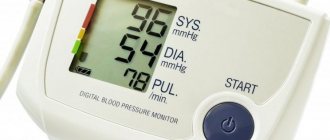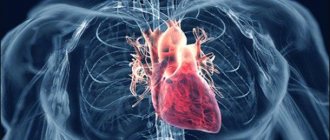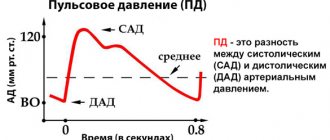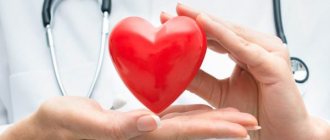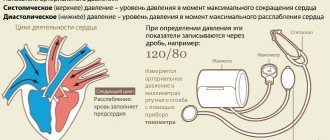Diagnostic methods
If systolic pressure is higher than normal, the specialist prescribes several diagnostic methods:
- electrocardiogram;
- general blood analysis;
- blood chemistry;
- examination of the heart through a phonendoscope;
- echocardiography;
- Dopplerography.
In case of dysfunction of the kidneys, gastrointestinal tract, or heart, specialists prescribe additional examination by specialized specialists:
- gastroenterologist;
- nephrologist;
- cardiologist.
To make a diagnosis, the patient is sent home, where he must monitor arterial parameters during the day under different conditions. He writes down all the data in a special diary. It records the time of measurement, activity, and well-being. Based on the data, the doctor will be able to determine the type and extent of the disease.
In the absence of timely therapeutic assistance, the patient may have a heart attack, develop acute heart failure, diabetes mellitus or gout.
If systolic pressure is increased and diastolic pressure is normal, the risk of complications and pathologies in the functioning of internal organs and vital systems increases:
Symptoms and clinical manifestations
More than half of ISAH cases are asymptomatic until clinical manifestations are already at the stage of serious complications: cerebrovascular accidents, myocardial ischemia. Symptoms do not depend on the form of the disease. Isolated high systolic blood pressure is characterized by the following symptoms:
- migraine pain;
- retrosternal discomfort of varying degrees;
- chronic fatigue, loss of performance;
- mood lability;
- impaired concentration and memory;
- symptoms of “fly spots” flickering before the eyes, periodic darkening of the eyes, decreased visual acuity.
The crisis form of ISAH is accompanied by nosebleeds, fainting, and vascular pulsation appears. However, more often no specific symptoms are recorded, the patient is unaware of the pressure surge.
If such conditions develop constantly, this leads to the inability to lead a normal lifestyle, reduces the potential for physical activity, and ends in disability.
Holter allows you to determine the form and type of pathology. Arterial hypertension, when the upper pressure is high and the lower pressure is normal, in almost 70% of cases is combined with diabetes, vascular atherosclerosis, and myocardial ischemia, which provokes the development of cardiovascular complications.
Folk remedies
Treatment with traditional methods should be carried out under the supervision of a doctor. How to lower blood pressure with herbs and other activities without drugs:
- Massage the temporal and frontal area with your fingers, this will help you relax.
- Take a sitting position and alternately lower your legs into warm and cold water for 2 minutes and 30 seconds, respectively.
- Chop the garlic (a couple of heads) and add 200 ml of water. You should drink half a glass of the infusion daily, but not for long.
- A vinegar compress is useful. Mix water and apple cider vinegar in equal proportions, dip and wring out a towel, and stand on it with your feet.
- Mix beet and lemon juice and honey in equal proportions and drink daily until blood pressure levels normalize.
- It is useful to take hawthorn, but the course of treatment is at least 2 months.
- A mixture of honey and walnuts also has a beneficial effect on systolic blood pressure when taken regularly.
- Eat fresh lingonberries, they normalize blood pressure.
Taking folk remedies should not be fanatical. Choose one or two options, don't go overboard.
Zinaida, Krasnoyarsk
Diagnostics
All people suspected of having ISAH should consult a doctor and get diagnosed. It is carried out to confirm a stable increase in upper blood pressure, identify the stage of the disease and exclude the development of a secondary form of pathology.
When making a diagnosis, a medical history is taken to familiarize yourself with the patient’s complaints and check his predisposition to hypertension. Patients with a predisposition to such diseases require constant monitoring.
After collecting anamnesis, dynamic blood pressure measurements are taken to determine the level of deviation from the norm. When measuring blood pressure, you should adhere to the following recommendations:
- Before the procedure, you should make sure that the patient is completely calm, since in this state it is possible to obtain true blood pressure values.
- It is necessary to sit the patient correctly so that his hands are at chest level.
- Measurements are taken 2-3 times on both hands at once. In this case, a break of 5-7 minutes is taken between each measurement.
When making a diagnosis, a medical history is taken to familiarize yourself with the patient’s complaints and check his predisposition to hypertension. Patients with a predisposition to such diseases require constant monitoring.
The essence of pathology
Blood pressure is generally understood as the ability of blood to press on the vascular walls. The indicator is assessed by the excess of the compressive characteristics of the fluid in the system above atmospheric pressure. This is an important indicator that indicates the condition of the organs of the circulatory system.
When measuring blood pressure, two indicators are always assessed. Systolic pressure gets its name from the term "systole". The indicator is the upper one and demonstrates the force of pressure in the arteries at the time of heart contractions.
This process is accompanied by compression of the ventricles and pushing of blood through the vessels, resulting in pressure. The parameter depends on the work and health of the heart muscle.
The speed and strength of heart contractions are of no small importance. Blood enters the circulatory system during one systole and penetrates into the arteries in a short period of time. The upper pressure depends on the resistance provided. The stronger the resistance, the higher this indicator. The norm is considered to be 120 mmHg. Art.
However, much depends on the age category and characteristics of the body. In some situations, the parameter can be 130-140 mmHg. Art. If this value increases, hypertension is diagnosed.
After systole, the next stage begins, which is accompanied by contraction of the ventricles and relaxation of the atria. Then comes the next phase - diastole. Its duration is only 0.4 s. After which the blood enters the peripheral vessels, filling the atria and ventricles.
Diastolic pressure indicates the condition of the peripheral vessels, since the heart is at rest. An increase in this indicator indicates the appearance of barriers to blood flow. The disorder may be due to a decrease in the elasticity or tone of the vascular walls. Kidney diseases also lead to it.
If elevated systolic pressure is detected, while diastolic pressure is normal, we are talking about isolated systolic arterial hypertension (ISAH). Most often, this disorder is diagnosed in older people.
The pathology is caused by a decrease in the distensibility of the main arteries - primarily the aorta. The physiological norm of this vessel is considered to be the reception and suppression of the intensity of cardiac output due to elasticity.
If the aortic wall becomes more rigid, different pressure is required to push blood out. Therefore, his performance is increasing. At the same time, this disturbance does not affect the functioning of small vessels in any way, therefore the diastolic parameter remains normal.
Points for lowering lower blood pressure
To reduce high blood pressure, you can massage special biological points. If acupuncture is done correctly, it improves the functioning of the heart muscle and blood vessels, improves breathing and blood circulation. This practice has been known since ancient times; it was usually used among eastern peoples.
Before you act, you need to measure your blood pressure. Then find two points. The first BAP is located on the scalp slightly above the crown of the head; it needs to be massaged while sitting for 2-4 minutes. The second BAP is located along the spinal column, just below the border of hair growth from the back of the head. It’s easier to massage these points yourself; you shouldn’t experience any pain or inconvenience. It is easier for you to sit, your back is straight, your shoulders are relaxed.
It would also be beneficial to massage symmetrical points in the area of the shoulder blades - between the third vertebra of the thoracic segment of the spine and the shoulder blade. But in this case, independent massage is excluded. You need to lie on your stomach, completely relaxed, and an assistant will massage these points.
In military medicine, they practice influencing a biologically active point on the pad of the middle finger. In this case, pressing will be painful. But it is very important to endure this pain for a minute. By the way, this action not only reduces blood pressure, but also relieves a person from muscle pain, as well as headaches.
What does doctor Liu Hongsheng advise to do:
- In order to improve overall well-being, this specialist suggests stroking from the earlobe to the collarbone 10 times;
- Then he says to massage the point, which is located next to the earlobe (half a finger towards the nasal wings), you need to massage for a minute.
This acupressure should normalize blood pressure and stabilize the condition of hypertensive patients. Believe it or not is up to you, but if you follow the steps of the method exactly, it really works. But how often you can resort to such influences on biopoints, at what pressure you can do this, and when it doesn’t make sense, check with your doctor.
Causes and possible dangers of ISAH
Many people are interested in the reasons why the upper pressure is high and the lower pressure is normal. There are quite a few factors that lead to this deviation:
- Vascular dysfunction, atherosclerosis. This is most often observed in people over 65 years of age. As the body ages, blood vessels become less elastic, which leads to a decrease in the volume of blood that is pumped out by the heart.
- Changes in hormone balance. Quite often, an increase in upper pressure occurs in adolescents and is associated with hormonal changes in the body. Similar symptoms may occur during pregnancy.
- Pathologies of the thyroid gland.
- Kidney damage.
- Aortic valve disease.
- Unhealthy Lifestyle. The cause of the disorder can be stressful situations, bad habits, lack of physical activity, and poor nutrition.
The causes of high upper pressure may be hereditary factors. This is why it is so important to know what pathologies immediate relatives suffer from. Men under 50 years of age are much more likely to experience hypertension.
However, with age, similar problems can arise in women. Pathology usually appears during menopause and is associated with a decrease in the amount of estrogen in the body. It is these hormones that maintain the elasticity of blood vessels and prevent the development of atherosclerosis.
If the upper pressure increases, but the lower remains within normal limits, you should immediately consult a doctor. This condition can lead to the following consequences:
- cerebrovascular accidents;
- stroke;
- irreversible kidney pathologies;
- acute myocardial infarction;
- the appearance of malignant hypertension;
- blurred vision.
Symptoms
At the initial stages of development, the pathology has an asymptomatic course. Signs of the disease may appear already at the stage of destruction of internal organs and tissues. Therefore, any signs of a violation should be grounds for contacting a doctor.
The main manifestations of the disease include the following:
- general weakness;
- increased excitability, anxiety, irritability;
- breathing problems;
- nausea and vomiting;
- blurred vision;
- bluish skin, especially in the area of the nasolabial triangle;
- chills;
- nosebleeds;
- headaches - localized mainly in the occipital region.
Important: One of the main symptoms of pathology is blue lips. This indicates a decrease in the amount of oxygen in the blood. In such a situation, you should immediately consult a doctor. An increase in heart rate and difficulty breathing also indicate the seriousness of the problem.
Diagnostics
To cope with the pathology, an accurate diagnosis should be made in a timely manner. The doctor must conduct a detailed examination to rule out damage to the kidneys and thyroid gland. To reduce blood pressure, it is necessary to establish the reasons for its increase. For this, the following studies are usually prescribed:
- general blood test - allows you to assess the content of red blood cells and hemoglobin levels, identify inflammatory processes;
- general urinalysis - helps evaluate kidney function;
- biochemical study - allows you to draw conclusions about the functioning of the kidneys and liver;
- electrocardiogram – provides information about the functioning of the heart;
- ultrasound examination of the kidneys and heart;
- lipid profile - allows you to determine the amount of cholesterol and identify atherosclerosis.
If necessary, the doctor may recommend performing an ultrasound examination of the blood vessels and chest x-ray. Consultation with a neurologist and ophthalmologist is often required.
Treatment of ISAH
When high systolic pressure is detected, choosing the right treatment can be quite difficult. In such a situation, only an integrated approach will help achieve the desired effect. The doctor will tell you what to do in this case. It is imperative to follow a diet, make adjustments to your lifestyle, and exercise.
General recommendations
If the systolic pressure is 140-160 mmHg. Art., you can try to lower it at home.
With high upper pressure, the following advice is given for treating the disorder:
- Weight loss. Excess body weight significantly increases the load on the heart. As a result, your blood pressure may increase.
- Dieting. If problems arise, it is recommended to reduce the amount of animal fats. At the same time, you need to eat a lot of fruits and vegetables. This will avoid cholesterol deposits in the blood vessels.
- Elimination of salt. It is recommended to reduce the daily volume of this product to 5 g.
- Quitting alcohol consumption and smoking.
- Moderate physical activity. It helps strengthen blood vessels and makes the heart more resilient.
Drug therapy
If compliance with general recommendations does not produce results, the pathology should be treated with medication. Only a doctor should select medications. It is strictly forbidden to change the dosage or group of drugs on your own.
Today, the following categories of medications are used to reduce blood pressure:
- diuretics - such tablets are prescribed for the appearance of edema and congestive heart failure;
- beta blockers - help reduce heart rate, but are contraindicated for people with bradycardia;
- calcium channel blockers;
- ACE inhibitors – are actively used in the development of isolated arterial hypertension;
- angiotensin II receptor blockers.
Folk remedies
In addition to traditional remedies, you can use effective folk recipes:
- Foot baths of different temperatures. To normalize your well-being, it is recommended to immerse your feet in warm water for 2 minutes, and in cold water for 30 seconds.
- Acupressure of the temporal zone, forehead, crown.
- Vinegar compress. To do this, mix apple cider vinegar and water in equal parts. Moisten a towel in the resulting mixture and stand on it with your feet.
- Alcohol tincture of calendula. This remedy should be taken three times a day in the amount of 30 drops.
- Cold compress. To carry out the procedure, you need to apply an ice compress to your neck 3 times a day. Hold the ice until it melts, then lubricate the area with oil.
- Garlic infusion. To prepare it, you need to chop a little garlic, add warm water and drink half a glass.
What to do if a pathological condition develops
Treatment can be prescribed by a doctor only after a thorough examination of the patient.
Low blood pressure does not always cause inconvenience to a person and his state of health does not change. However, if unpleasant sensations appear that are long-lasting, this means that you need to immediately consult a doctor. At the first examination, the specialist will check the blood pressure level, listen to the heart rhythm and find out the characteristics of the development of symptoms. After this, the patient will be referred to undergo a diagnostic examination, which will help determine the cause of the low level of upper pressure. Based on the data obtained, the doctor will prescribe therapy, which must be comprehensive to achieve maximum results.
Traditional methods of solving the problem
The factors that can lower upper blood pressure are different, and therefore the methods of dealing with hypotension are also different. These include:
Lifestyle adjustments
It is important to establish the body’s biological rhythms; sleep should be at least 8 hours a day. After waking up, it is advisable to do a set of physical exercises and have a healthy breakfast. Medicines
To correct blood pressure, the doctor recommends taking medications containing caffeine. The most effective are Aspirin, Citramon, and Dobutamine. Physiotherapy. A person is prescribed magnetic therapy, cryotherapy, reflexology, massage.
Traditional methods of treatment
Supplementing therapy with fireweed tea will speed up the desired effect.
Together with traditional therapy, non-traditional methods are used that have a powerful effect without side effects. Common remedies for low blood pressure include:
- tincture of ginger, honey and lemon;
- tea based on fireweed angustifolia;
- aloe juice;
- butter rub;
- tinctures from aralia, ginseng, leuzea;
- a remedy made from lemon, coffee beans and honey.
The cardiovascular system often suffers due to the influence of various pathological factors. However, improper human behavior can also affect health. A decrease in the upper level of blood pressure may be a temporary phenomenon, but this does not negate its danger to life, especially with a rapid decrease to critical levels.
Prevention
To prevent problems from arising, you need to prevent the occurrence of isolated systolic hypertension:
- get rid of excess weight;
- reduce the amount of salt in the diet;
- eat foods containing calcium, potassium and magnesium;
- stop drinking alcohol;
- carry out anti-stress therapy;
- control the course of diabetes mellitus in the presence of such pathology;
- Use any medications only under medical supervision.
An increase in upper blood pressure against the background of normal lower blood pressure may indicate dangerous disorders. To cope with the pathology, it is necessary to conduct a comprehensive examination and strictly adhere to the doctor’s recommendations.
Did you like the article? Save it!
Still have questions? Ask them in the comments! Cardiologist Mariam Harutyunyan will answer them.
Ivan Grekhov
Graduated from the Ural State Medical University with a degree in General Medicine. General practitioner
What to do if the upper pressure is high and the lower pressure is normal
Such tonometer indicators indicate stiffness and poor elasticity of blood vessels, which causes a slowdown in blood flow and its entry into the capillaries.
To eliminate the problem, medications are prescribed to lower blood pressure, ensuring that the lower reading does not decrease.
In this case, it is recommended to take:
- Papazole is a diuretic and antispasmodic agent that relaxes blood vessels.
- Nifedipine - lowers blood pressure, eliminates an attack of angina. The release form is capsules, it is important to take it with plenty of water.
- Metoprolol and Captopril - reduce heartbeat, half the tablet is placed under the tongue.
It is also very good to engage in physical therapy; what procedures to carry out and for what amount of time should be indicated by the attending physician.
Nutrition plays an important role; you should remove unhealthy foods from your diet and consume less salt and fat. Be sure to give up alcohol and quit smoking.
If you do everything together, your blood pressure should recover within a month, maybe sooner.
Let's watch a video about the reasons for increased lower pressure:

